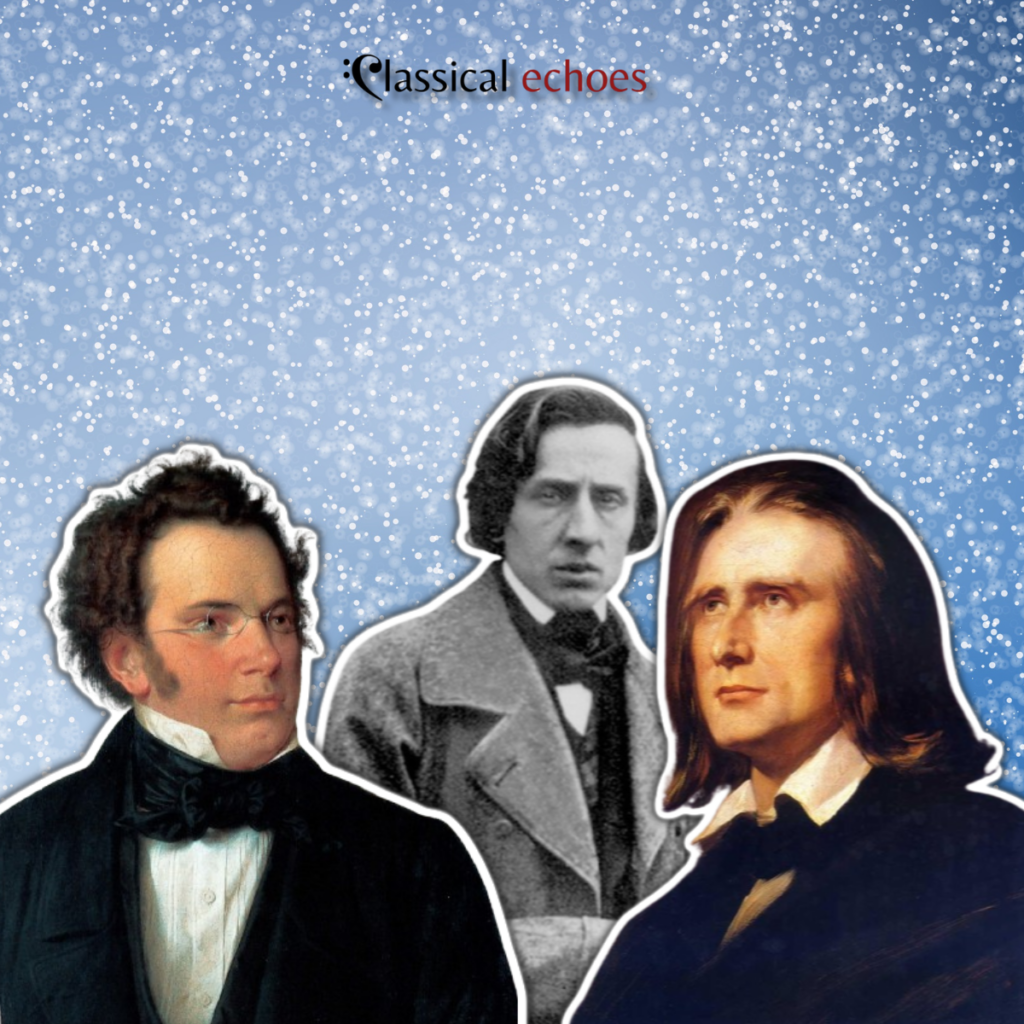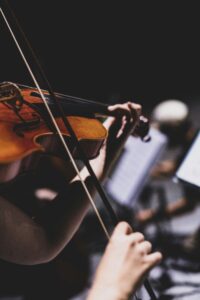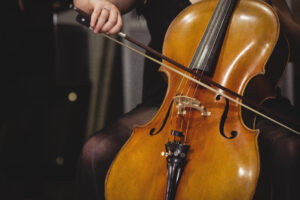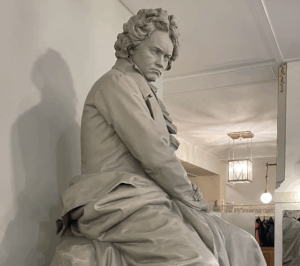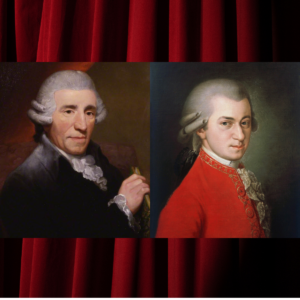Winter is one of the most loved and exciting periods of the year. There are many traditions and customs associated with winter holidays, as well as with the winter season in general.
It’s no wonder that classical composers throughout history have dedicated countless works to the winter, from light and joyful melodies to more profound compositions. Here are 11 of the best classical pieces for winter!
J. S. Bach – Christmas oratorio
Bach’s Christmas Oratorio is a six-part choral suite composed by Bach for Christmas in 1734. It is intended to be performed in church during the Christmas season.
Each part includes a choral section, cantata, some of which were composed by Bach earlier in his life. Many of the tunes and texts were taken from previous works and from different authors.
The cantatas’ texts include many Lutheran hymns, which Bach often used, especially in his religious music. Some cantatas contain texts by Luther, Rist, Gerhard, and others, written for choir and solo.
Bach’s Christmas Oratorio may not be as well-known as other works on the list, but it is an important religious composition. It is frequently performed during church masses at Christmas season, showing Bach’s glory to God and admiration of this sacred holiday.
Christmas Oratorio (by Harnoncourt, yt. Thanasis Baltas)
A. Vivaldi – The Four Seasons (Winter)
Vivaldi’s Winter is one of the four violin concertos from his famous Four Seasons, composed in 1723. It is part of a larger set titled Il cimento dell’armonia e dell’inventione (The Contest Between Harmony and Invention), which showcases Vivaldi’s talent for illustrating scenes from life through music.
Winter is divided into three movements, following the typical structure of a Baroque concerto. The opening movement, Allegro non molto, is the most famous and the one most people refer to when speaking of Vivaldi’s Winter. It begins with intense chords in the cold key of F minor. Here, Vivaldi creates a dramatic, icy atmosphere, representing the harshness of winter and a fierce snowstorm.
The second movement, Largo, is warmer and more peaceful in contrast to the first. It is also more melodic and set in a major key, creating the feeling of a calm, sunny winter day.
The final movement combines elements of the previous two. It transitions from grim melodies to energetic climaxes, represented here by virtuosic violin solos.
Interestingly, Vivaldi included detailed performance instructions in the score, such as “teeth chattering” or “horrible wind”. These notes describe how he wanted the music to feel for the listener.
A. Vivaldi: Inverno(Winter) – Voices of Music
Related:
The 13 Darkest Classical Pieces
V.Hely-Hutchinson – Carol Symphony
The Carol Symphony was written by english composer Viktor Hely-Hutchinson in 1927. It is a four-movement orchestral suite of preludes for Christmas, meant for concert performance during the festive season.
Each movement contains traditional Christmas carols, accompanied with classical orchestra. The preludes are based on popular carols like “The First Nowell,” “God Rest Ye Merry, Gentlemen,” and “O Come, All Ye Faithful”.
The Carol Symphony creates a warm and joyful atmosphere of the holiday season, making it one of the most popular Christmas tunes. Hely-Hutchinson did a great job on delivering the Christmas mood and winter vibe through his music.
Carol Symphony (yt. AntPDC)
F. Chopin – Winter Wind
Winter Wind – No. 11, Op. 25, is one of Chopin’s most famous études. As the name suggests, the composer sought to depict a cold, harsh winter wind.
The étude, however, starts with unexpectedly gentle, repeated notes. Played in a march-like tempo, they gradually build into A minor chords. Then, the main theme bursts forth with an intense and dramatic tune, like a freezing winter wind.
The fast, descending notes in the right hand represent a swirling snowstorm accompanied by rhythmic chords in the left hand. The music maintains this intense tempo throughout, depicting the relentless and powerful nature of a wind, building a fierce atmosphere similar to Vivaldi’s Winter.
Listening to this piece, it becomes clear how challenging it is to play on the piano. This étude is designed to develop stamina and hand flexibility. Although it doesn’t have a warm, Christmas-like winter atmosphere, it perfectly illustrates the cold and fierce nature of a winter wind.
Pollini plays Chopin’s Winter Wind (yt. NewFrancFerencLiszt)
F. Liszt – Chasse-neige
Chasse-neige (Snow-whirl) is the last piece in Liszt’s Transcendental Études and one of his most poetic and charming etudes. As the name suggests, it paints the picture of a swirling snowstorm.
The piece begins with quiet, mysterious notes in the left hand. It focuses on tremolos, which sound like cold wind. Unlike in Chopin’s étude, the theme here grows gradually into increasingly intense melody.
The cold key of B-flat minor adds to wintry atmosphere. The main theme, accompanied by crescendos and descending tremolos, makes it one of the most poetic études.
It then builds up into several climaxes, which are particularly powerful in terms of the vibe of the piece. This is one of the best compositions to listen to on a cold, lonely winter evening.
E. Kissin – Transcendental etude no. 12 (yt. Aleksandr Solzenicyn)
P. Tchaikovsky – Seasons: February
In 1875, Nikolay Bernard, an editor of a popular musical magazine, commissioned Tchaikovsky to write short pieces representing each month. Tchaikovsky accepted the challenge and later presented the work that entered musical history as The Seasons.
The Seasons is a piano suite where each short piece represents a month of the year. Similarly to Vivaldi, Tchaikovsky included comments by famous poets and writers in the original score. The work later gained popularity among other musicians and was also transcribed for orchestra.
Among the three winter months, February is probably the most exceptional in terms of sound and atmosphere. Titled Carnival, it begins with a quick and joyful melody. The marking, a quote from P. Vyazemsky’s poem:
At the lively Mardi Gras soon a large feast will overflow
Hints at the upcoming spring and the start of the new year.
The mood of the piece can also be associated with January because of the holiday season. However, for Tchaikovsky February was particularly warm and enjoyable month.
O. Sheps plays Tchaikovsky’s February from Seasons
F. Schubert – Winterreise
Schubert’s Winterreise is a 24-song cycle composed by Franz Schubert in 1827, near the end of his life. It is based on poems by Wilhelm Müller and is considered one of the most famous collections of Lieder. The songs tell the story of a wanderer traveling through winter landscapes, experiencing different feeling and the emotions during his journey.
Each song in the cycle has its own unique mood and theme. Some of the pieces were composed earlier in Schubert’s life. Titles like The Inn, Dream of Spring, and Last Hope picture unique scenes of winter. The seemingly simple songs for voice and piano actually create a cozy and dreamy winter atmosphere.
You can easily imagine sitting by a fireplace on a cold, snowy January evening, listening to the abstract wanderer’s journey through winter villages and forests, encountering new people and places, and experiencing the beauty of the winter season.
Schubert’s Winterreise is now one of the most well-known classical song collections, although it did not receive much attention during his lifetime. It’s the perfect work to enjoy after the Christmas holidays, as you watch the snow falling outside your window.
If you’re fortunate enough to understand German, you can appreciate the beauty of Müller’s words. However, Schubert’s extraordinary ability to convey feelings and emotions through his music vividly brings the songs to life, even without understanding the lyrics.
Schreier/Richter preform Schubert’s Winterreise (yt. Addiobelpassato)
J. S. Bach – Brandenburg Concerto No. 4
Bach’s Brandenburg Concerto No. 4 is one of six concertos he wrote as a gift for the Margrave of Brandenburg in 1721. It was originally written for solo violin and two flutes, accompanied by a small string orchestra and harpsichord.
The G major theme and light, playful melody create an image of snowy winter and cheerful holiday seasons. The concerto consists of three movements and has a similar overall structure and mood to the other Brandenburg concertos.
In the first movement, Bach includes violin tremolos and flute accompaniment that create the image of snowfall and white winter landscapes. The main theme was taken from his previous works and later reused in some of his cantatas. In fact, this was why the Margrave didn’t pay Bach for the work, as he had expected the original themes. Nevertheless, it remains one of Bach’s most beloved compositions.
While the Brandenburg Concertos weren’t written specifically for winter, like his Christmas Oratorio, this work has a fitting sound for the cold season. In contrast to some darker pieces, it is particularly positive and cheerful, expressing the joy of winter.
K. MacLeod – Bach’s Brandenburg Concerto 4 in G major (yt. Audio Library – Free Music)
A. Corelli – Concerto Grosso in F major
Corelli’s Concerto Grosso in F Major, Op. 6 No. 6, is one of 12 concertos from his famous Op. 6 collection, published in 1714. Corelli, known for his elegant and balanced Baroque style, composed this set to highlight the contrast between the small group of soloists (concertino) and the larger orchestra (ripieno).
The concerto is divided into five short movements, ranging between slow and fast tempos. The gentle, flowing melodies and beautiful ornamentation create a warm and peaceful mood, while the allegro sections are more energetic and cheerful. This balance of moods makes the concerto perfectly suited for winter, especially the holiday season.
While Corelli wrote lighter and harmonically simpler music compared to Vivaldi and Bach, he created this charming atmosphere in his works. This simplicity make Corelli’s concertos some of the most performed Baroque music during winter. The F Major Concerto, in particular, creates the feeling of snow and winter joy, similar to Bach’s Brandenburg Concertos. However, all of Corelli’s concertos share this delightful atmosphere and charm.
A. Corelli – Concerto Grosso in F major (Voices of music)
P. Tchaikovsky – The Nutcracker
We finally come to what is probably the most wintry work out there – The Nutcracker. It is one of Tchaikovsky’s most famous ballets, and even more renowned is The Nutcracker Suite. The work has become a symbol of Christmas and New Year, perfectly capturing the winter mood.
Tchaikovsky composed and premiered his ballet based on E.T.A. Hoffmann’s The Nutcracker and the Mouse King, with its first performance taking place at the Mariinsky Theatre in St. Petersburg. Interestingly, the ballet didn’t achieve the same popularity initially as The Nutcracker Suite, which Tchaikovsky presented nine months earlier.
Pieces like “The Dance of the Sugar Plum Fairy” and the “Chinese Dance” have become musical symbols of winter and Christmas. Today, The Nutcracker is one of the most performed ballets worldwide, evoking a warm and joyful winter atmosphere for many people.
Dance of the Sugar Plum Fairy from The Nutcracker – Royal Ballet and Opera

